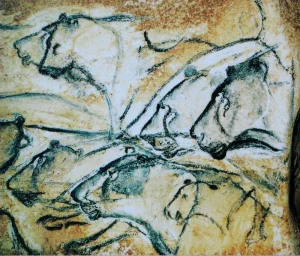
One of the world’s most ancient works of cave art appears to be even older than originally assumed, according to a new analysis of the ancient mural found on the Indonesian island of Sulawesi, offering profound implications regarding the cognitive and social development of one of our fellow hominids. Additionally, there has also been a recent discovery on the nearby island of Flores of an even smaller individual belonging to a species nicknamed “Hobbits” due to their diminutive size, suggesting that there is more than one evolutionary path that humanity could be destined to follow.
Found on the walls of South Sulawesi’s Maros-Pangkep karst lies a 14-foot-wide mural depicting humans armed with spears that are hunting what appear to be warty pigs and dwarf bovines. Previous dating attempts placed the creation of the artwork as far back as 43,900 years ago, but a new, more accurate method using pulsed lasers, has pushed that date back by another 4,040 years.
This method, called laser ablation inductively coupled plasma mass spectrometry (or LA-ICP-MS for short) uses a nanosecond-pulsed laser to vaporize a tiny portion of the material being sampled—less than one-fifth of a millimeter is needed for a typical reading—with the constituents of the resulting plasma being measured by a mass spectrometer.
The spectrometer compares the ratio of the different naturally-occurring thorium and uranium isotopes present in the sample; much like the process used for shorter time periods using carbon-14 dating, the amount of each of the isotopes left in the sample indicates how much time has passed since the pigments were last applied.
“This method provides enhanced spatial accuracy,” according to the study paper released by the researchers. This new measurement resulted in a date 4,040 years earlier than the previously-assumed age, pushing the creation of the mural back to over 51,000 years before present.
“Painted at least 51,200 years ago, this narrative composition, which depicts human-like figures interacting with a pig, is now the earliest known surviving example of representational art and visual storytelling in the world,” the authors of the new study state.
But there’s a curious twist to the appearance of cave art at such an early date on Sulawesi: although there are traces of human habitation in the region dating back 194,000 years, there is no indication that modern humans were present in the region before 25,000 years ago—meaning it is highly likely that these ancient artworks were made by one of our close relatives, possibly H. floresiensis, who called the nearby island of Flores home at the time. Although modern humans may have left Africa as far back as 90,000 years ago, it’s assumed that our most direct ancestors hadn’t yet made it far outside of the continent at the time the Maros-Pangkep art was being composed.
If this artwork was created by another hominin species, this could hold major implications for the cognitive development of our earlier cousins (not to mention that of our own H. sapiens ancestors), due to the mental complexity required to create figurative artwork that effectively communicates such an event like the one depicted in the mural, and the social complexity that would benefit from this level of communication.
“This implies that a rich culture of storytelling developed at an early period in the long history of H. sapiens in this region—in particular, the use of scenic representation to tell visual stories about human–animal relationships,” the research paper states.
Assumed to have been subject to what is known as “island dwarfism”, where an isolated species shrinks in response to diminishing resources, the individual that the bone belonged to would have stood no taller than 108 centimeters (42.5 inches), making them the smallest known hominid.
Already nicknamed “Hobbits” due to their diminutive stature, these individuals appear to represent an evolutionary path that took the species in a direction opposite to that of modern humans, shrinking in order to take better advantage of their environment, while our more immediate ancestors grew in size.
“We think it was destiny [for humans] to become clever,” remarked study co-author Yousuke Kaifu, an anthropologist at the University of Tokyo, regarding the corresponding shrinking of Flores Man’s cranium. “Flores tells us that there are other ways for humans to be.”
There are some indications that Indonesia’s Flores Man may still inhabit the island’s forests, meaning Whitley’s 2018 novel New, an exploration of what contact with a previously undiscovered non-human species might be like, might have more to do with reality than anyone realized.
|
ReplyReply allForward |
Subscribers, to watch the subscriber version of the video, first log in then click on Dreamland Subscriber-Only Video Podcast link.
Remembering this interview. MOST UNSETTLING…….
Disappearances in Indonesia
May 29, 2010
https://www.unknowncountry.com/insight/disappearances-in-indonesia/
PART OF THE INTERVIEW:
An Unknowncountry.com reader, Alan Lamers, working on the island of Sulawesi in Indonesia reports that many people are disappearing in the jungle, apparently due to a very unusual form of abduction that takes place if they wear certain colors. Some are returned, but generally with no memory of what happened to them.
His report follows:
I am on an island called Sulawesi in Indonesia. To be exact, I a writing this from the city of Makassar also known as Ujung Pandang Sulawesi Selatan (South Sulawesi).
I started running across this story about 3 years ago when I went to a small village in the district of Sandu Batu in South Sulawesi. I was told not to bring any clothing with yellow in it or any other bright colors to wear in the jungle. Only Black or White. Black was the most preferred. I had to ask why. They said that people who wear these bright colors will disappear.
This is the single most disturbing interview in the history of Dreamland and Unknowncountry
Yes, very odd